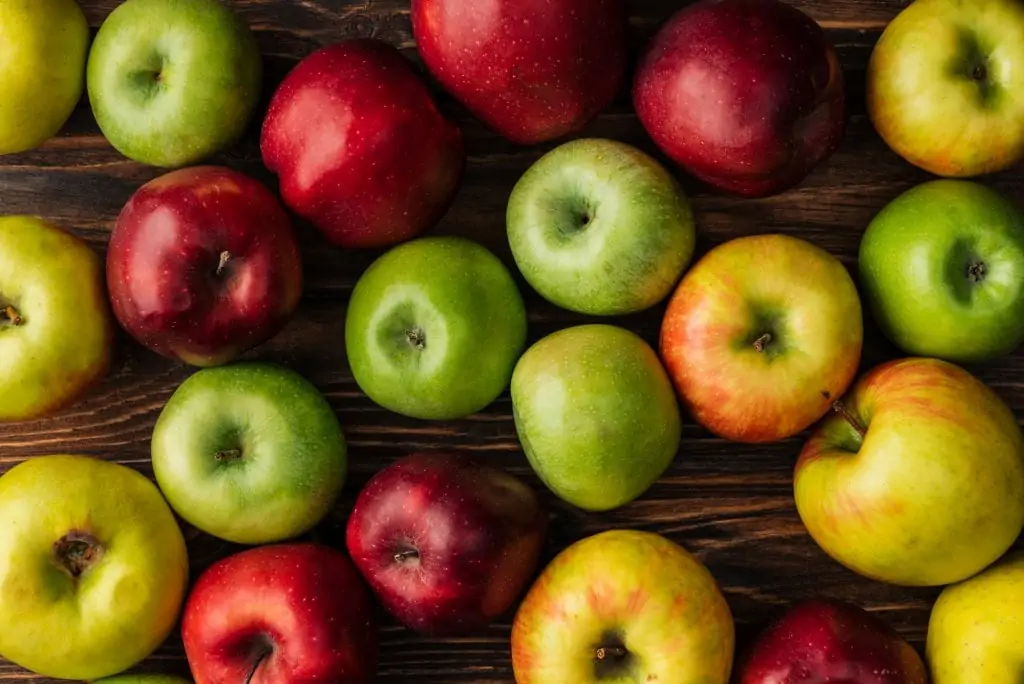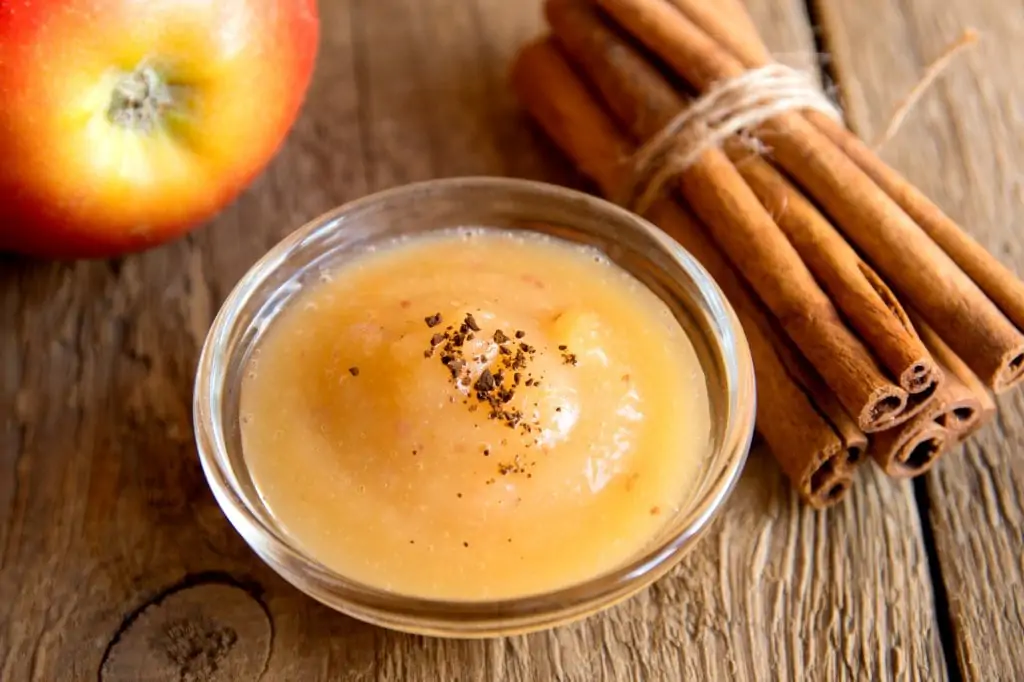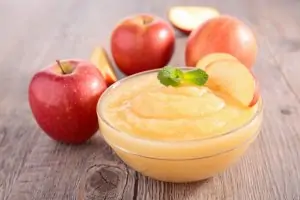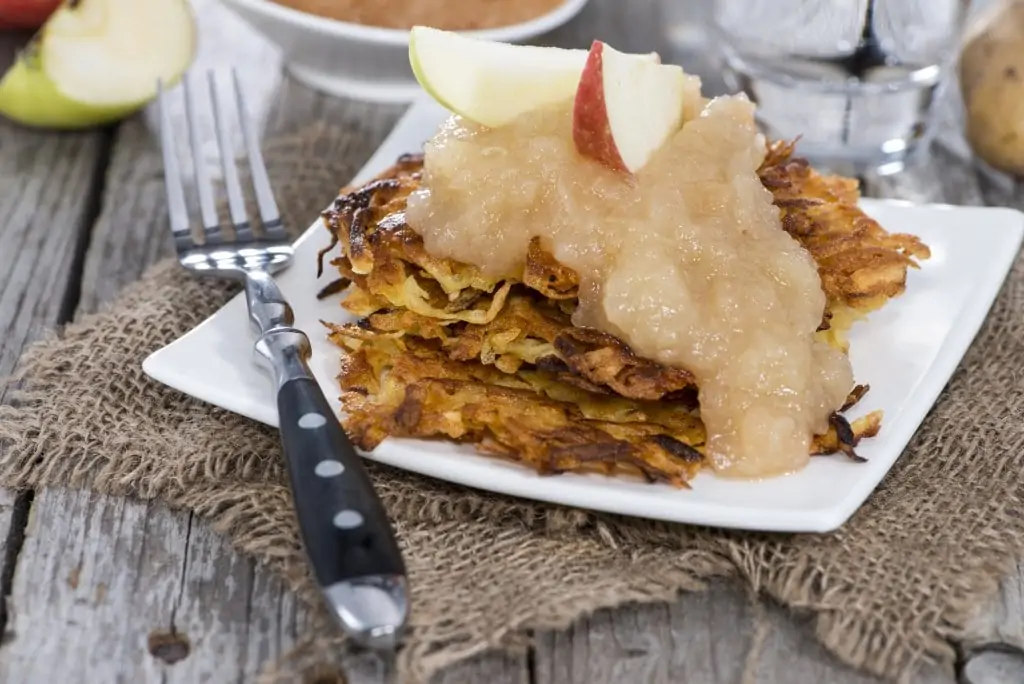Everyone loves applesauce, from babies to great-grandparents. But it tastes even better when you make it yourself in your own kitchen.
Homemade applesauce has a rich flavor and can be as sweet or tart as you like it. It almost tastes like that all-American apple pie filling that we love. Store-bought applesauce simply cannot hold a candle to the taste of homemade.
There are three reasons why you should try making your own applesauce.
First, it’s so easy. All you’ll need for the most basic applesauce recipe are apples, a bit of water, and some lemon juice or vinegar.
Second, you know what’s in your own applesauce. Store-bought sauce may have added ingredients or preservatives that you don’t want for your family.
And, finally, homemade applesauce is simply better for you than store-bought. Granted, homemade applesauce doesn’t have the same amount of vitamin C found in store-bought brands (store-bought brands often add Vitamin C, which acts as a preservative).
However, homemade applesauce contains more antioxidants called phytochemicals, especially when you include the apple’s skins in the sauce. These help reduce the risk of heart disease, diabetes, and even cancer.
If it’s your first time making your own applesauce, we have a simple homemade applesauce recipe that can be made with just five ingredients. It is tried-and-true delicious and can be eaten as a snack, healthy dessert, or as a side dish to savory dishes such as roast pork or your favorite sausages.
If you’re feeling “saucy” (get it?), we also provide ideas for variations on your applesauce. Make it sweeter, or add cinnamon, or make it extra-smooth in your food processor or blender. It’s all up to you.
We will also share with you how to properly store extra applesauce so you can enjoy your delicious homemade creation year-round.
Don’t forget: applesauce is also handy to keep around to use in recipes such as muffins and vinaigrettes.
And if you love to bake but need to watch your calories, substituting the same amount of applesauce for butter or oil in baked goods is an old trick that lowers fat content but doesn’t sacrifice taste in sweet treats.
What Kind of Apples are Best for Applesauce?
The best apples to use for applesauce are the older and softer ones because they cook down faster than younger, less ripe ones. There is no specific variety of apples that is the absolute, universally-agreed-upon best variety for applesauce.
However, it’s obviously best to use apple varieties that taste best when they’re cooked or baked. Some common varieties of these are:
- Gravensteins
- Granny Smith
- Pippin
- Fuji
- McIntosh
- Jonathan
- Jonamac
- Golden Delicious
To make your applesauce turn out even better, choose a mix of two or three varieties. This gives you lots of options based on your personal preferences: some cooks like to use both the sweet and tart variety, while others look for a sharp taste with a little bit of tang.
The Fuji, Golden Delicious, and Jonathan varieties are sweeter than the other varieties. McIntosh, Gravenstein, and Jonamac apples are a bit sweet and tangy, while the Granny Smiths and Pippins will provide that bite of tartness to your applesauce.

Our Favorite Applesauce Recipe
After exhaustively trying quite a few recipes in our kitchen, we have settled on our favorite homemade applesauce recipe. When you taste this, there’s a big chance you’ll forget that the supermarket variety even exists!
The recipe’s level of sweetness is just perfect. The tartness of the lemon juice intensifies the taste of the apples and helps neutralize the sweetness of the sauce. The addition of cinnamon and salt creates a perfect balance of flavors.
Ingredients:
- 8-10 apples
- 3 tablespoons lemon juice
- ½ teaspoon ground cinnamon
- ½ cup or less brown sugar (optional)
- 1 cup water
- ½ teaspoon salt
Steps:
- Peel, core, and quarter the apples. When done, boil the apples in a large pot. Add the lemon juice, cinnamon, brown sugar (if using), water, and salt.
- Bring to a boil in high heat. Cover the pot. Lower the temperature and maintain a low simmer for 15-20 minutes or until the apples are completely cooked through and tender.
- Remove the pot from the heat.
- Use a potato masher to mash the cooked apples in the pot using a potato masher or the back of a wooden spoon to break the mashed apples to desired consistency. For smooth applesauce, blend in a food processor.
- Adjust the taste if necessary. Add more sugar if you want it sweeter, more cinnamon for more spice, and lemon juice for more tartness.

Variations for Applesauce
- Use maple syrup as a substitute for white sugar for a more natural sweetening of your applesauce. A liquid sweetener is also easier to add at the end if you decide that your sauce needs extra sweetness.
- If you prefer a tarter applesauce, or if your baking apples are all of a sweet variety, just omit the sugar or maple syrup and make unsweetened applesauce.
- If you like a smooth sauce, run the apple mixture through a food mill or purée with an immersion blender.
- If you don’t have a lemon, you can use a bit of apple cider vinegar instead.
- Sick of cinnamon? Spice up your applesauce with clove, ginger, or nutmeg.
- If you feel you need to add more sugar, wait until the apples have fully cooked. The natural sweetness of apples intensifies when cooked and you might not need to add as much sugar as you initially thought.
- You can make applesauce in a pinch by cooking it in the microwave. Place diced apples in a bowl, cover, and cook for four minutes or until they have softened. Then, transfer the cooked apples to a food processor. Add all the remaining ingredients.
- Aside from a microwave, you may also be able to cook an applesauce recipe using a slow cooker or rice cooker.
How to Store Applesauce
In case you made more applesauce that you need or can use and you want to store the extra sauce, you can do so easily so that you can use it later on.
- Pack the sauce in an air-tight container and put it in the fridge. Refrigerated homemade applesauce can last up to a week.
- If you want to keep it longer than that, make sure to put the air-tight container in the freezer. It will keep for almost a year.
- If you’re going for an even longer shelf life for your applesauce, try canning it. Applesauce is inherently safe to can in a warm bath due to the high acidity and sugar content of apples. That said, as we haven’t tried canning this recipe yet, we’re not sure it’s safe to do so. We advise that you proceed carefully if you try to do this, but there are other proven recipes available for canned applesauce.
How to Freeze Applesauce
- Place your pot filled with applesauce in an ice water bath. To help it cool down even faster, replace the water that warms up throughout the process with fresh, cold water.
- Pour the cooled-down applesauce into clean glass jars or plastic containers, leaving enough headroom for expansion. About an inch will do. Leaving room at the top of the container is important since the applesauce will expand when it freezes.
- Put your containers in the freezer right away. Do not leave the applesauce sitting at room temperature or it could go bad. You should write the freezing date on the container with a permanent marker for future easy checking to see how long it’s been in your freezer.
- You can leave your applesauce inside the freezer for a little less than a year. To defrost, let it sit at room temperature until it gets slushy enough to eat.
How Can I Use All This Applesauce?
Applesauce, especially if made from a homemade recipe, is a healthy and delicious snack on its own, as school-age children will quickly tell you. But there are a lot of other ways you can enjoy it, as well.
We have some awesome suggestions to inspire you to look at your beautiful jars of applesauce in a different light. Applesauce is more than something you put on the side in a lunch box.
- Serve over pancakes, muffins, and quick breads
- Use as ice cream topping
- Pile on toast with peanut or almond butter
- Swirl into oatmeal as a sweetener instead of sugar
- Serve hot with roast pork or sausages
- Add to your morning smoothie
- Use as fat/oil substitute in your favorite muffin and cake recipes
- Pair with your favorite tangy cheese
- Use as an ingredient in a banana pudding recipe for a quick dessert
- Make a lightly sweet and crunchy granola by mixing applesauce, peanut butter, and oats
- Create a perfect base for a sweet and tangy vinaigrette
Conclusion
It’s a wonder there aren’t more folks who know how to make applesauce from scratch since it’s one of the easiest and most delicious multi-purpose foods anyone can make.
DIY applesauce can be a sweet treat, snack, condiment, or ingredient that you can make from scratch. The bonus? It doesn’t take much time or money to make at all.
Let’s not even start with the various things you can do with homemade applesauce. You can enjoy it in so many delicious ways.
Since most cooks have specific varieties of apples they like to use when making applesauce, you can choose whatever apples you prefer, as well. Using a mix of varieties will bring extra dimension in flavor and texture to your applesauce.
Aside from being able to use it in a number of ways, applesauce can be stored for future use. It can last almost a year in the freezer, which means you can enjoy applesauce all the year around!
Frequently Asked Questions
How do you make applesauce from scratch?
It’s super easy to make applesauce from scratch. The most basic recipe has only four ingredients: apples, water, lemon juice, and a fresh cinnamon stick.
Peel, core, and slice the apples into small chunks. Then, place in a large saucepan or pot. Add in water, lemon juice, and cinnamon stick.
Bring to a boil on high heat and then simmer on low heat for 20-30 minutes, or until the apples are soft. If you want a smoother sauce, blend in a food processor or blender, or use an immersion blender.
How is applesauce made?
You start by choosing your preferred apples. There are a lot of apple varieties out there, but it’s best to pick a blend of apples for your apple sauce. This way, each variety will bring its own different level of sweetness or tartness and texture to make the applesauce even more amazing.
Then you need to core the apples. They do not need to be peeled unless you prefer to do so. (They are more nutritious with the peel anyway.) Next, dice the apples. Don’t be worried about being neat: it doesn’t matter how well or evenly you dice them.
Place the diced apples into a pot and add just a touch of water, since the apples will produce juice while being cooked. If you want to add a sweetener, add just a little sugar or maple syrup to start. You can add more at the end if needed, according to taste.
Add the spices if you are adding any. You may also add lemon juice or apple cider vinegar at this point. They are used to preserve the color. They also provide the needed acidity to ensure safe storage for the cooked applesauce.
Cook the apples on medium heat until they are completely soft. Mash with a potato masher to either a chunky or smooth consistency. If you want an extremely smooth applesauce, use an immersion blender, blender, or food processor.
Is it cheaper to make your own applesauce?
Making your own applesauce at home will cost you less than buying it at the grocery store. Individual servings for six four-ounce cups of store-bought applesauce usually cost between $2-$3, whereas a three-pound bag of apples generally costs less than $8 and can render about 2 1/2 quarts of applesauce.
The price difference, however, becomes less significant as you add more ingredients to your applesauce. There are other variables to consider, also, aside from the ingredients.
The price of apples matters, since it follows that they are cheaper when they’re in season. Whether you buy in bulk or not also makes a significant impact on the cost. In other words, it is not always easy to make a price comparison between the two.
That said: store-bought applesauce does not even come close to the richly flavored, tangy, smooth flavor of the homemade kind. You may be investing much more of your time by cooking applesauce from scratch instead of simply purchasing it, but if the applesauce is stored properly, you can have enough leftovers to last almost an entire year. You and your family will be able to enjoy the “fruit of your labor” for a long time.
What apples make the best applesauce?
Any variety of apples can be made into applesauce, but if you are unsure, go with the softer varieties like Golden Delicious or Fuji. The McIntosh apple, especially, has a tender flesh that breaks down easily when cooked, making it a great choice for homemade applesauce.
We all pretty much know that when you choose apples to use for baking an apple pie, you want the apples to be firm and crisp. But you would want the opposite type of apples for applesauce. Besides being able to cook down more easily, softer and riper apples should also mash easily to create a more flavorful sauce.
Many recipes suggest using a mix of different types of apples. Each variety brings a distinct flavor and texture, thus adding dimension to your apple sauce.
How do you make store-bought applesauce taste better?
Store-bought applesauce’s texture is often grainier and more watery than the homemade type, which is silkier. Store-bought also does not have the complex flavor of homemade applesauce. But if you’re out of homemade, you can luckily jazz up the grocery store applesauce in your pantry.
The easiest way to get some more flavor in a blander store-bought sauce is to drizzle real maple syrup on top, and then sprinkle with cinnamon. If you like a bit of tartness to go with the sweetness, you can add a splash of apple cider vinegar, too.
You can just as easily add browned butter and salt to the applesauce instead for a sweet and buttery treat. If you want a spicy twist on the traditional sauce, add cayenne pepper (trust us!).
How do you thicken up applesauce?
There are times when apples produce more juice than expected or when you accidentally just add too much water to the pot. That leaves you with watery applesauce. What to do? Don’t worry: there’s an easy way to thicken it. You just need to cook it a bit longer to allow the excess water to evaporate.
To help speed up the process, you can transfer the applesauce to a skillet to provide it with a larger surface area on which to evaporate more quickly.
Another way to thicken applesauce is to let it sit in a cheesecloth-lined mesh strainer for a few minutes to allow the excess liquid to drip into a pot. The best thing about this method? You can use the liquid to make apple cider!
There are a number of ways to prevent or fix runny applesauce. If you want a thick sauce, don’t remove the skins before cooking the apples. Also, don’t overcook them, since they will tend to lose their shape and create a runny sauce.
Additional Resources
- Food Network: 5 Ways to Use Applesauce
- YouTube: How to Make Homemade Applesauce







Rose Reinhard is a Thai-American foodie from Chiang Mai, Thailand. She's been a creative writer since she could speak and enjoys making vegetarian/vegan dishes and reading about food science. She claims her air-fryer is the best purchase she’s ever made to date.